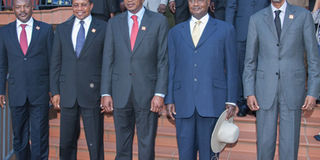Tough road ahead for EAC single currency

PHOTO | NATION President Uhuru Kenyatta (centre) with his Eastern African counterparts, President Pierre Nkurunziza (left), President Jakaya Kikwete (second left), President Yoweri Museveni (second from right) and President Paul Kagame (right), after the session for consideration and adoption of the Communique's of the summit during the 15th Ordinary Summit of The East African Community Heads of States at Speke Resort, Kampala.
What you need to know:
- The protocol sets out a 10-year road map for economic convergence among EAC member states that will culminate in the adoption of a yet-to-be-named regional currency.
- A draft monetary union protocol seen by the Sunday Nation stipulates that the full implementation of the customs union and common market protocols, signed in 2000 and 2005 respectively, as the prerequisites towards the journey to a single currency.
- Levels of reliance on tax revenue as opposed to debt for financing budgets in the countries still differ. This is problematic given that one of the convergence criteria listed by the protocol is maintaining a debt-to-gross domestic product (GDP) ratio of no higher than 50 per cent.
Negotiations over the East African Monetary Union protocol that was signed yesterday have been long and often strenuous.
However, in playing out the signing ceremony in Kampala, presidents from the five partner states have set the East African Community (EAC) on a perhaps more difficult journey.
The protocol sets out a 10-year road map for economic convergence among EAC member states that will culminate in the adoption of a yet-to-be-named regional currency.
It is expected that the achievement of the monetary union will improve the business climate in the region by cutting cross-border transaction costs. Businesses will also be better protected from foreign exchange distortion by a theoretically more stable currency.
“Having a monetary union would enhance free movement of goods and people as well as increase the investment opportunities in the region,” said Institute of Economic Affairs analyst, Mr John Mutua.
Before this can be achieved, however, the region will have to confront old ghosts. The sort of macro-economic convergence envisioned will require significant ceding of sovereignty over certain aspects of fiscal planning. Sovereignty has always been a sticky issue among the partner states.
But the EAC will first have to fully implement two previous protocols that have been frustrated by protectionism, bureaucracy and poor infrastructure.
A draft monetary union protocol seen by the Sunday Nation stipulates that the full implementation of the customs union and common market protocols, signed in 2000 and 2005 respectively, as the prerequisites towards the journey to a single currency.
The customs union was expected to scrap tariffs while the common market protocol was to allow for the freedom of movement for factors of production.
Economists maintain that without the full implementation of these two, the full impact of the monetary union will not be realised.
“If you cannot do business freely across the borders or move your goods, you cannot feel the full benefits of a single currency,” said economist Gitau Githongo.
NON-TARIFF BARRIERS
Recent efforts by three partner states, Kenya, Uganda and Rwanda, to fast-track the elimination of non-tariff barriers to trade in the region have led to fragmentation of the EAC.
In trying to establish a customs territory, scrapping tourist visa requirements and easing the movement of people within their borders, the three countries have been accused of alienating Burundi and Tanzania.
Mr Githongo says that disagreements on such basic levels do not portend well for the implementation of the monetary union. Nevertheless, he contends that actualising the two protocols may be the easier part. Establishing the mechanisms for fiscal and monetary convergence may prove trickier.
The draft protocol envisions harmonisation of government policy as pertains revenue collection and expenditure. Countries are supposed to disclose their budget financing and implementation processes.
This is already happening–to a certain extent. Countries in the region have made the symbolic step of harmonising their fiscal calendars and reading their budgets on the same day.
Levels of reliance on tax revenue as opposed to debt for financing budgets in the countries still differ. This is problematic given that one of the convergence criteria listed by the protocol is maintaining a debt-to-gross domestic product (GDP) ratio of no higher than 50 per cent.
Despite making gains made over the last decade, at the close of the 2012/2013 financial year in June, Kenya recorded a 51.7pc debt to GDP ratio.
“Debt levels should not be outside the sustainability levels in any single country. It would not be good for stability of the single currency,” said Kenya Institute of Public Policy Research and Analysis (Kippra) analyst, Benson Kiriga.





